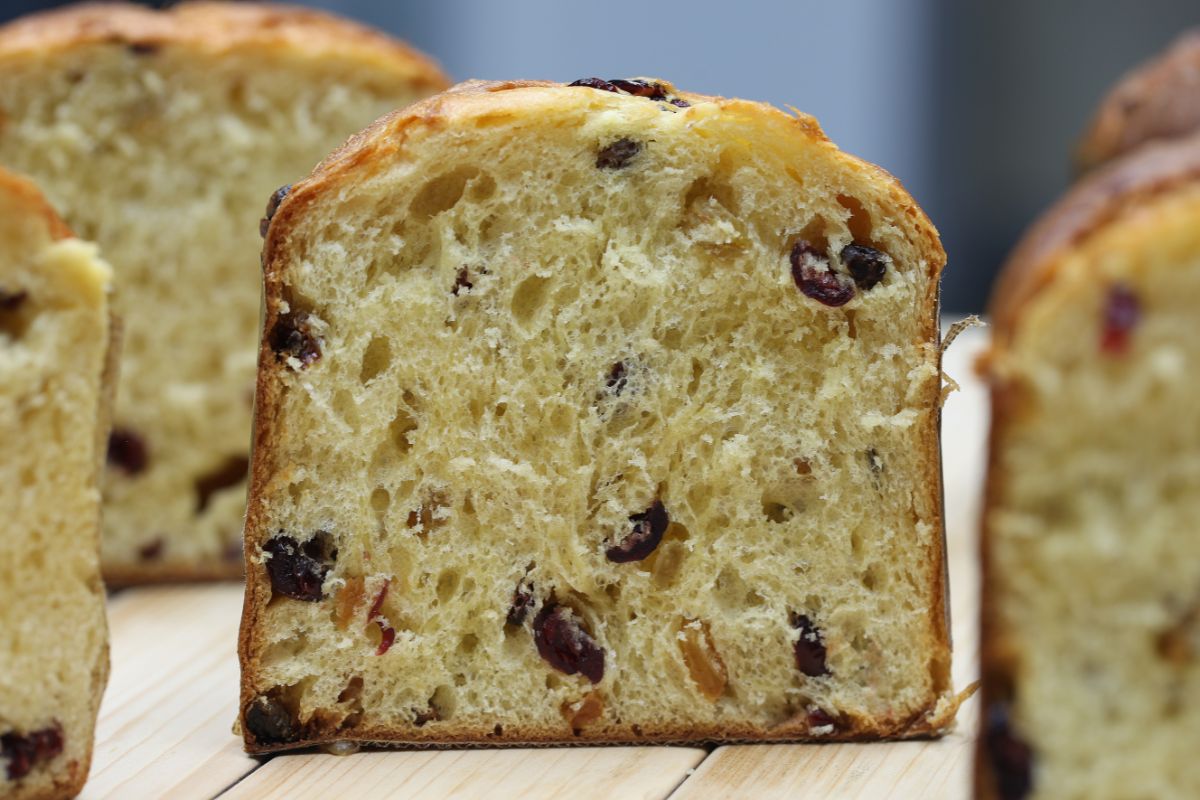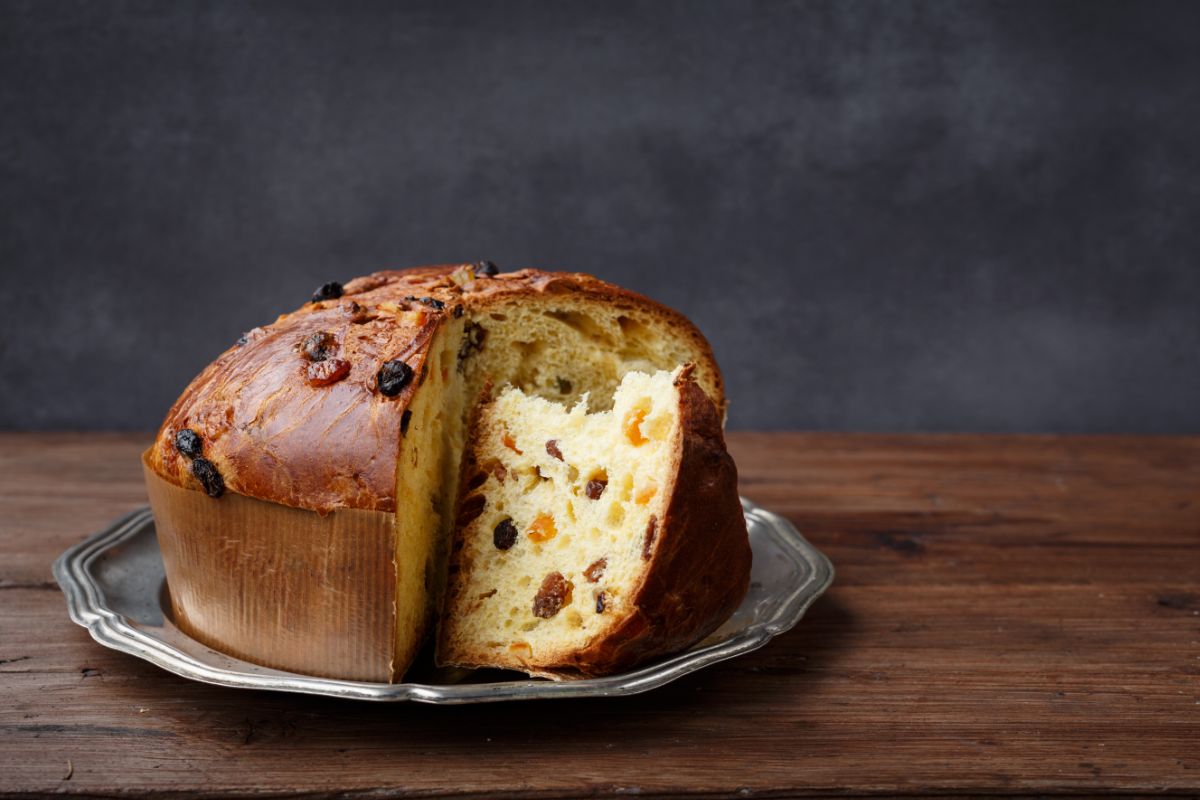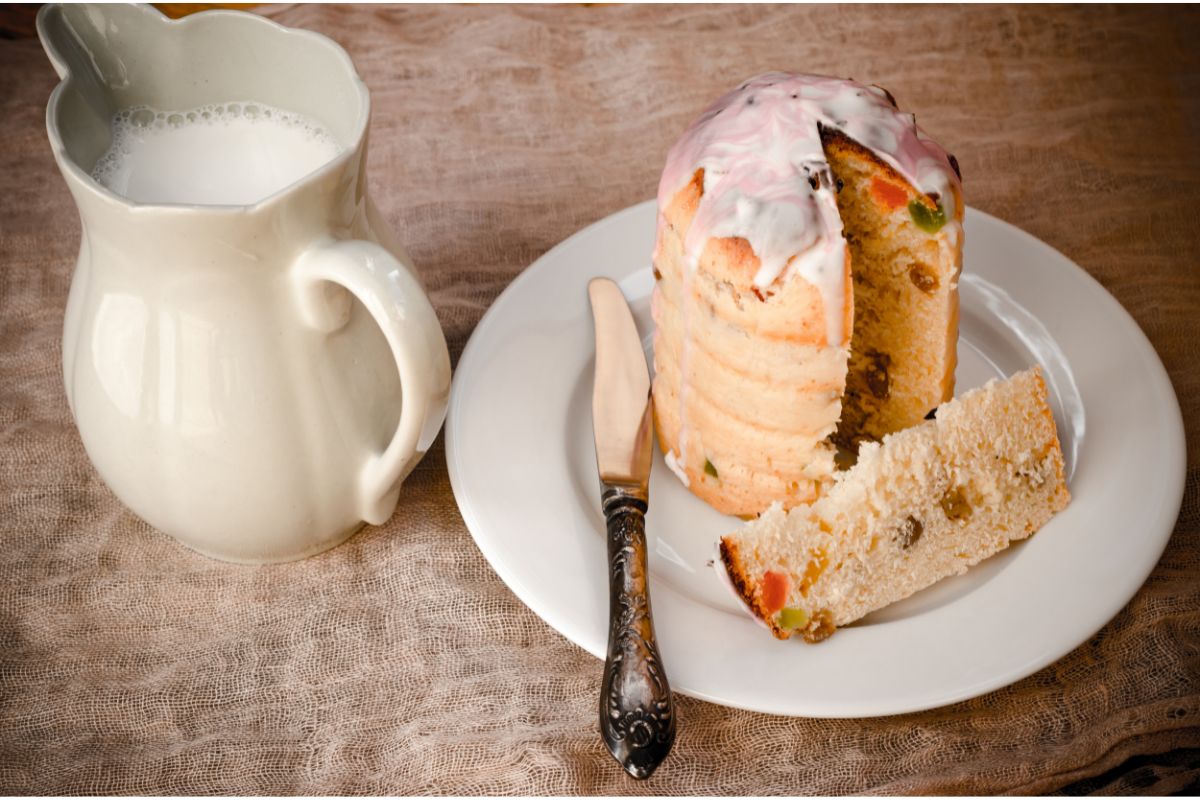Is Panettone Bread or Cake?
If you are a lover of Panettone, then the most important thing is finding out where to buy Panettone bread. But first things first, is Panettone bread or cake? It’s a huge, fruity-enriched sweet bread that people traditionally serve at Christmas, and Italian populations enjoy it worldwide.
They use raisins, candied fruit peels, and almonds. The best Panettone has brandy as the main flavor.

The Origins of Panettone
Panettone has existed since 1839, when an Italian-Milanese dictionary mentioned it for the first time. The Smithsonian Magazine describes this dish as a “homegrown Lombard delicacy since the 19th century,” with cookbooks such as Giovanni Felice Luraschi’s Nuovo Cuoco Milano Economico firmly establishing roots in the area around Milan by the 1850s.
This Italian Christmas bread is quite popular among Italians. It’s such a huge thing that it had to undergo an accreditation process under Italian law in 2005, and foreign sales now account for around 10% of total annual production!
Italians link the Panettone to a romantic story. According to legend, Ughetto, a nobleman and falconer, fell in love with Adalgisa, the daughter of a baker whose business had run into difficulties. The family was dissatisfied with his decision and banned him from marrying her, but he did so anyway because “how could any man resist such beauty?”
Ughetto tracked down the bakery where his lover worked and accepted a position there. He bought butter and sugar, which he mixed into the bread mixture. The result was Ughetta’s sweet bread, which quickly became popular! This prevented the bakery from collapsing, and Adalgisa (his sweetheart) was happy about the change.
He added raisins and candied peel to the mix to keep delighting her. This bread was so popular that it outsold everything his family had ever made! They finally gave their blessing to their marriage.
The Ingredients
Butter, wheat, eggs, sugar, raisins, and other fruits and peels are the main ingredients for the Panettone recipe. Wheat is in short supply during Christmas, yet it is a prized component in Milan.
Wheat was an important ingredient of many meals that Italians ate around the world in the 1900s– it was less then. However, it still made an appearance with every baker churning up their favorite Christmas treat: little wonder there were shortages!
According to Executive Chef Henk Drakulich, their most popular item is the Italian Panettone, light and fluffy bread. It has a unique flavor profile because of an Italian sourdough starter, which gives it a brioche texture rather than the sweet texture of other pastries on shop shelves or in bakeries.
Because of the amount of time spent fermenting from scratch before baking, the consistency of this dessert-like treat is bread-like. It stays slightly sweet without getting overly sugary, unlike unfermented dough, which begins to taste different when all those natural sugars convert during storage.
Where to Buy Panettone
If you don’t have the time (or energy) to prepare Panettone, a good alternative is to buy an Italian Panettone cake from stores. People normally wrap the dried fruit in an airy dough in a traditional Panettone recipe. It should be taller than it is wide at all times.
The top of the Panettone Italiano will usually have some decoration to let you know which flavor it is famous for, which is generally citrus or chocolate. If they’re not round loaves, modern versions come in other shapes, such as hearts. It doesn’t matter what form you use if you meet the necessary.
Panettone commerciale is an Italian fruit dessert prepared with candied fruits and raisins. You can also top it with hazelnut, chocolate, or almond toppings. This Italian delicacy dates to the 18th century, when it was initially sold in Italy as a luxury item for those who could afford it during the Christmas season.
Because of the expensive cost of manufacture, which included a lengthy fermenting process before baking in special wood-fired ovens, some people couldn’t afford them. You can buy a Panettone Italian Cake on Amazon. Here are some:
This traditional Christmas Milanese cake has a 36-hour leavening time, five kneading steps, and a manual “dough rounding,” as tradition demands. A 7-hour head-down rest is also part of the meticulous preparation.
Vergani Dark Chocolate Chip and Italian Coffee-Flavoured Panettone, Sugar Iced, Gourmet Line – 1lb 10.4oz/750g
Pasticceria Vergani baked a sugar-iced Panettone with dark chocolate and coffee powder in Milan. You can top up this naturally leavened Panettone with an almond-flavored sugar frosting.
It has a 36-hour leavening time, five kneading steps, and a manual “dough rounding,” as tradition demands. A 7-hour head-down rest is also part of the meticulous preparation.

A Traditional Panettone Recipe
Time: 16 hours and 15 minutes
Preparation Time: 40 minutes
Cook Time: 75 minutes
Serving Size: 10 to14 servings
Nutritional Facts/Info Per Serving
- Carbs – 2.05oz (58g)
- Protein – 0.32oz (9g)
- Calories – 460
- Fat – 0.74oz (21g)
Equipment
- You need fresh skewering in the Panettone cake preparation. You’ll need long skewers to wrap the bottom of your oven-safe dish completely.
- Large cans or Panettone papers.
- Strong mixer.
Ingredients
Fruit
- 10 oz (0.38 kg) dried fruits in a mixture (raisins, currants, cranberries, dried cherries)
- 4 oz (0.15 kg) finely chopped candied orange and lemon peel
- 2 oz (75.6 g) quartered glacé or candied cherries
- Cointreau, or your favorite liqueur or fruit juice, six tablespoons
Dough
- 4 cups bread flour (strong)
- 1 teaspoon fine salt
- 6 large eggs
- Unsalted butter, 10 oz (0.38 kg)
- Blanched whole almonds, 1 oz (37.8 g)
- 1 1/2 tablespoons dry fast-acting yeast
- 1.75 oz (66.15 g) (or 1/4 cup) refined sugar
- 6 oz (0.23 ml) milk
Instructions
Make the Fruit
- Gather all ingredients (raisins, cherries, currants, cranberries).
- Combine all of the candied and dried fruits in a mixing bowl.
- Pour in the Cointreau and stir once more.
- Cover and store in a cold, dry location. Do not store it in the refrigerator.
Make the Dough
- Combine yeast, almonds, milk, water, butter, eggs, sugar, flour, and salt in a mixing bowl.
- In a heatproof jug or basin, sprinkle the dried yeast over the warmed milk. Add the sugar and set aside for five minutes.
- Put the flour in a large mixing bowl. Sprinkle salt on one side of the dough and pour the frothy yeast mixture over the other, being careful not to mix any dried or fresh yeast with its bath, as this will kill it!
- Combine the flour, yeast, and salt in a mixing bowl. Mix in five eggs at a time on low speed until the dough is smooth.
- Melt the butter in a large mixing basin and chop it into small pieces. Raise the mixer’s speed to be high and add one piece at a time until all nine ounces (0.26 kg) incorporate.
- Allow the mixer to run for five minutes to achieve a glossy, even smoother dough that is so soft it will be impossible to handle without feeling greasy! This is the texture you’re after—a “clean” texture that works well in any dish.
- Allow the final 1/2 oz (0.08 kg) of butter to glide into place in the greased bowl by its weight. Do not press any dough out since this will result in air pockets and an undercooked loaf!
- Allow the dough to rest and rise in the fridge overnight after making it. Even better than before, the cold will maintain its shape! Because slow is usually better when cooking yeast-risen baked goods like these loaves of bread, you’ll also end up with a light but an airy cake with a gorgeous soft crumb.
Making the Panettone
- Spread the dough out on a floured work surface into an even rectangle.
- Using a sieve, strain the soaked fruits. Place half of the fruits on the spread-out dough, discarding the juice.
- To properly arrange the fruit, fold the dough and lightly roll it around each one. Then, if necessary, spread out with a rolling motion until you incorporate all your components into one lovely dish!
- Form the dough into a ball with a rough shape. This will keep your pie from drying out and guarantee it bakes up with just enough structure for a great outcome!
- With the remaining 1/2 oz (0.08 kg) butter, grease a seven-inch (17.78 centimeters) Panettone tin or paper case. If you don’t have either, use an 8-inch (20.32 centimeters) standard cake tin; line the bottom and sides tightly to prevent overflowing during baking, but don’t forget to grease these areas!
- Place a dough ball in the center of your baking pan, smooth it out with a butter knife, and top with almonds. Cover it with a tea cloth after that.
- Before baking, the dough must have enough time to rise. It must be higher than the tin’s rim.
- Preheat the oven to 350 degrees F (176.67 degrees C).
- Combine the remaining egg and a splash of milk in a mixing bowl. Brush over the cake and bake at 300°F (148.89°C) in the middle oven for 20 minutes; reduce heat to low and bake for another 45-55 minutes. When you insert the skewer into the Panettone, it should come out clean.
- Allow five minutes for the cake to cool in the can. You may then remove the cooled shape and place it on a cooling rack to ensure that no part of your masterpiece is dented or cracked!
How to Eat Panettone
How do you eat Panettone after preparing it? You can consume Panettone in a variety of ways. Let’s look at some of them:
Method One: Unwrap it and Slice it
Step 1: Take it out of the Package
Remove the wrapping paper off the sides of the Panettone first. Most people wrap the sides of the Panettone in cellophane or paper, sometimes both.
Step 2: Bring it to a boil (Optional)
If you prefer warm bread, now is the time to do so. This step is optional, but if you want warm bread, we highly recommend it. Bake the unwrapped Panettone for 5 to 10 minutes at 200 degrees Fahrenheit (93 degrees Celsius). Before you slice it, remember to take it out of the oven! You’ll end up in a dangerous scenario if you don’t.
Step 3: Slice it (This is not an option!)
Cut the Panettone into small triangle pieces with a bread knife. Take a bread knife and cut into the Panettone from top to bottom, much like you would a cake. To make your first thin slice, start from the same center point and cut out just a tiny bit from the center. Continue to cut the Panettone in this fashion until you have as many narrow pieces as you and your guests require.
Step 4: Add a Drink to the Mix!
Choose a beverage that corresponds to the time of day you serve your meal. Choose one of the following three options:
Option 1: Add coffee (breakfast) – Start your day with a slice of Panettone and a cup of coffee. Around the holidays, Europeans frequently eat Panettone for breakfast. Cut it into tiny pieces and serve with cups of your favorite coffee, alone or with other morning dishes.
Before eating, some people like to dip their Panettone into their coffee. Give it a shot if this seems appealing to you.
Option 2: Serve with masala (lunch) – Serve slices of Panettone with glasses of Masala as a mid-day treat. Serve slices of Panettone with Masala or another Italian wine if your family enjoys tea time or a quick afternoon meal, as many Europeans do. Prepare small plates and wine glasses for each visitor, then slice the Panettone and pour the wine.
Option 3: Serve with wine (dinner) – Serve Panettone with a glass of Moscato as a dessert. After dinner, as a dessert, or dolce, pair a slice of Panettone with a glass of sparkling white wine, such as Moscato or Spumante. You may find Italian sparkling white wine at your local supermarket or wine shop.
Step 5: Finish with a Dollop of Whipped Cream (Optional)
A whip cream touch will delight your guests. Save the bits for munching as nibbles. Fill the cavity with whipped cream before replacing the top of the bread. Slice the Panettone into small slices to serve your guests as you normally would.
Method Two: Tear and Dip
This is the standard method, which requires less effort. Instead of slicing your Panettone, tear it and eat it in a glass of milk. Another technique that Italians like Panettone is to eat it without cutting it. Simply unwrap your Panettone and place it on a plate.
Give each individual a 470 ml (14.1 fl oz) glass and tell them to rip out pieces of Panettone to put in it. Fill each glass to the brim with whole milk. Serve each individual a dessert spoon to eat their milk-soaked glass of Panettone.

The Final Say
The holiday season is approaching. What exactly does this imply? It’s time to make Panettone, the traditional Italian sweet bread loaf served at Christmas time, on every table. Many people repute Santa to enjoy this lovely and delicate treat! Why not try it yourself using the traditional Panettone recipe above!

Community of passionate writers and content creators who share a love for Italian heritage, culture, travel, food, and the Italian-American community. Our mission is to celebrate Italy’s rich history and traditions and connect with others who share the same passion.




